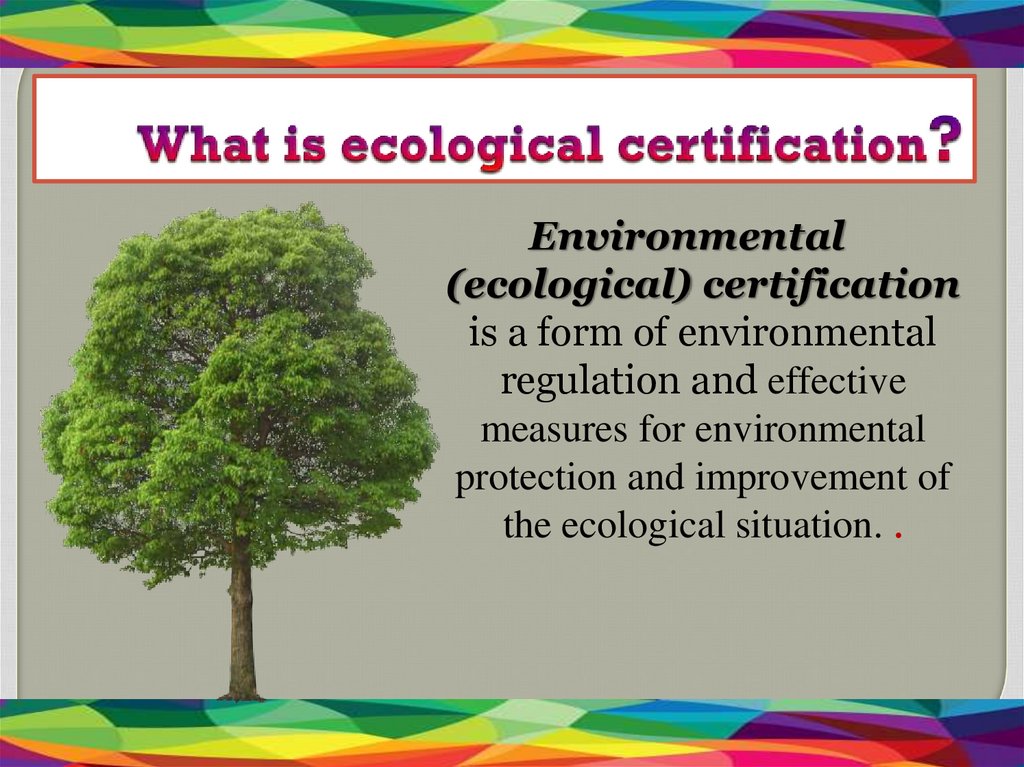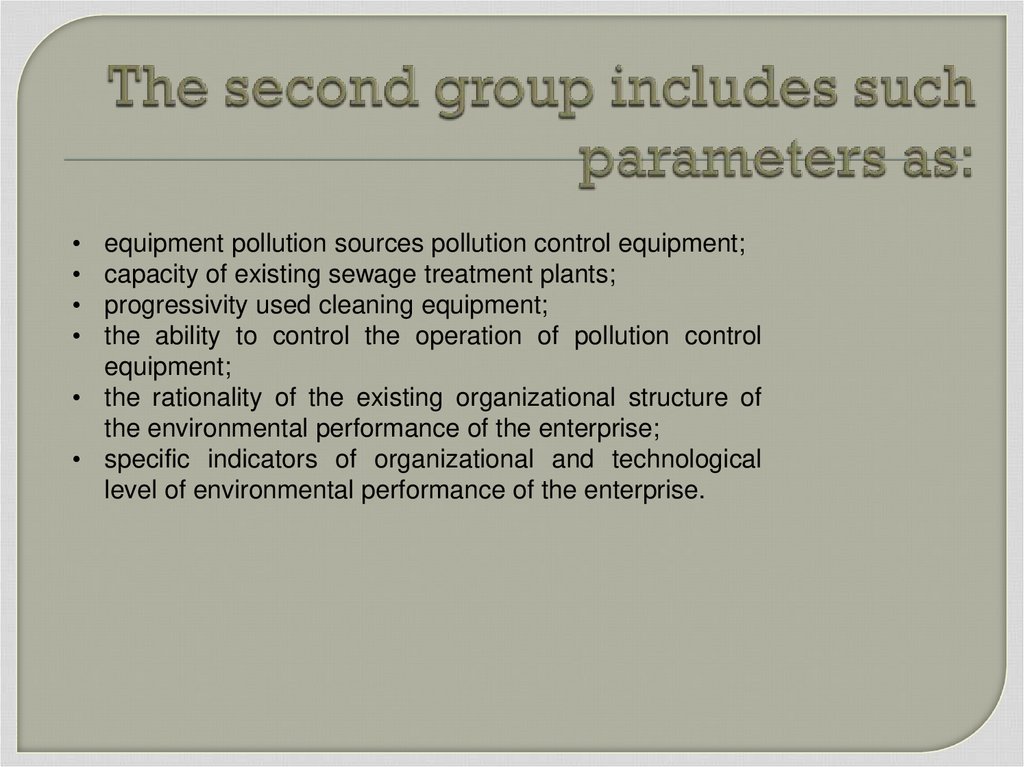Похожие презентации:
Ecological principles of sustainable development
1. Subject of Lecture 9-10
Ecological principlesof sustainable
development
2. Plan
NaturalResources
Rational Use as One of Aspects of
Sustainable Development
Characteristics of natural resources
and their classification
Environmental certification of
enterprise
3.
Natural resources are thebasis of life for any human
society.
Means of people living that
are not the result of their
labour are qualified as
natural resources. They are
water, soil, plants, animals,
microorganisms, mineral
products, cosmic resources
(solar energy).
4.
Thereare various classifications of
natural resources. For example, with
regard to the use the natural
resources are divided into industrial,
public health, aesthetic, scientific
etc.
5.
The most general classificationof natural resources is by their
exhaustibility. According to this
classification,
All natural resources are
divided into:
• exhaustible;
• inexhaustible.
The exhaustible resources,
in their turn, are divided into:
• renewable ;
• nonrenewable resources.
6. Renewable resources
Aliving component of the biosphere falls
under the category of renewable for
example, green plants, soil, fertility of
which is formed within a lengthy period
and is the most deficit resource.
However, the rates of using the
renewable resources must be
conformance with the rates of their
restoration; otherwise the renewable
resources may become nonrenewable.
7. Nonrenewable resources
Coal, petroleum, andnatural gas are
considered
nonrenewable because
they can not be
replenished in a short
period of time. These
are called fossil fuels.
8.
Cosmic, climatic and waterresources
fall
under
the
category of the inexhaustible
resources.
9.
- Thecosmic resource is solar
radiation.
Climatic resources are the
atmospheric air, atmospheric
precipitation, wind.
Water resources are water reserves of
the Earth. This resource is
inexhaustible on a global scale, but on
a local scale it may be exhausted (for
example, the Aral Sea).
10.
11.
12.
13.
Therational nature management has
twofold aim;
it
is necessary to attain the
preservation of nature with all its
diversity;
provide the growth in prosperity of
the population.
14.
15.
It is necessary to remember that the naturalresources are a part of ecosystems, in which all
ecological components are interrelated.
16.
17. Protected Areas
One of forms of environment protection being ofexclusive value is protected areas.
The forms of protected areas:
Reserves;
Wildlife sanctuaries;
Natural monuments;
National and natural parks;
Botanical gardens;
Biosphere reserves.
18. The Biggest Protected Areas on the World
National Park of Greenland – 7 millionhectares;
19. The Biggest Protected Areas on the World
The Central Kalahari Game Reserve,Botswana – 5.3 million of hectares;
20. The Biggest Protected Areas on the World
WoodBuffalo National Park,
Canada – 4.5 million of hectares.
21. Reserves on the Territory of Kazakhstan
There are operating 10 reserves:Aksu Zhabagly, Barsa-Kelmes, Almaty
Reserve, Naurzumsky, Kurgaldzhinski,
Markakolski, Ustyurt, Alakol, West Altai,
Karatau.
22. National Nature Parks in Kazakhstan
There are 8 National Nature Parks:Bayan Aul, Ile-Alatau, Altyn Emel,
Kokshetau Burabay,
Karakaralinskiy,
Katon-Karagay, Charyn.
23.
InJune 1992, at the World Forum in Rio de
Janeiro the Convention on Biological
Diversity was signed and ratified by
more than 100 states of the world. The
main aim of the Convention shall be to
sustain the rich diversity of life on Earth
and sustainable use of its elements.
24.
TheInternational Conference on
Biosphere Reserves (Seville, 1995)
developed the Seville Strategy for
Biosphere Reserves and the Role of
Biosphere Reserves in the 21st century.
25.
The biosphere reserves shall fulfill threecomplementary functions as follows:
protection to sustain genetic resources,
biological species, ecosystems and
landscapes;
the function of development to promote
sustainable economic and human
development;
26.
thefunction of material and
technical support to promote and
encourage activities in the field of
research, education.
27. Monitoring
Theconcept of monitoring was introduced
into the scientific literature in early
seventies of the last century, and it means
observation and exercising control over
changes in the state of biosphere and
ecosystems, populations, organisms
influenced by human activities, and also the
atmosphere, the water, the soil and human
health.
28. The environmental control system incorporates three major types of activities:
Trackingand control is a systematic
environmental monitoring;
Forecast is to determine probable
changes of weather under the influence
of natural and anthropogenic factors;
Management is measures and actions to
regulate the state of environment.
29. Two Main Groups of Standard Indicators:
Sanitary and Hygienic IndicatorsMaximum permissible concentrations
(MPC) of contaminants in the air, water,
soil, food products;
Maximum permissible emissions (MPE)
of contaminants in the air, water bodies.
Ecological Indicator
Regarded as a measure of anthropogenic
impact on ecosystems
30.
An important indicator of the state ofenvironment is the health of population, the
criteria of which are the infant mortality
dynamics, congenital anomalies of newborn
infants, diseases of children and adults.
31.
With the intent to build harmoniousrelations between the nature and
society it is necessary to solve three
the most important tasks:
1. To form a new type of social and
ecological thinking eliminating an
exclusive consumer approach to the
nature;
32.
1.2.
Wide publicity, enlightenment and
education of social and ecological
problems accompanying development of
human civilization;
Developing a business mechanism of
nature management providing full
coordination of individual, collective and
national interests in the area of
environment protection and rational use
of natural resources.
33. Environmental certification of enterprise
34. What is ecological certification?
Environmental(ecological) certification
is a form of environmental
regulation and effective
measures for environmental
protection and improvement of
the ecological situation. .
35. Environmental passport - a document containing information about the level of use of the nature user resources (natural,
36.
Ecological passport of the company refers toits basis and technological documentation, it
should be in every enterprise.
37.
EnvironmentalPassport gives you the
opportunity to analyze the ecological state of
the enterprise and the environment in the
region, to compare the ecological and
economic performance with other better
environmental protection measures.
38. Environmental Passport contains the following structural elements:
title page,
information about the developer of environmental passports
content,
general information about the users of natural resources,
environmental and economic indicators,
information about products,
a brief description of production,
39.
information on the consumption of energy,
ecological and production figures,
information on land use,
information about permissions (licenses) for the use of
natural resources and environmental protection
activities,
• Environmental Action Plan,
• a list of references.
40.
Environmental certification of enterpriseenvironmental assessment of production in terms of rational use of natural
resources
consumption of
raw materials
consumption
of energy
consumption of
natural
resources
emissions of
pollutants per unit of
production
assessment of the negative impact on the environment
Gross amount
of disposing
Gross number
of discharges
Gross amount
of solid waste
availability and effectiveness of treatment facilities
relationship management "enterprise - environment" by levying
pollution charges
41. The environmental passport of the enterprise reflects the three groups of indicators:
1st group: indicators of influence on a state of the environment;2nd group: indicators of organizational and technological level of
environmental performance of the enterprise;
3rd group: general and specific indicators of cost-benefit analysis
for environmental activities.
42. The first group includes the following indicators:
• environmentally friendlyproducts;
• the impact on water resources;
• the impact on the atmosphere;
• impact on material resources
and waste production;
• the impact on land resources.
43. The second group includes such parameters as:
equipment pollution sources pollution control equipment;
capacity of existing sewage treatment plants;
progressivity used cleaning equipment;
the ability to control the operation of pollution control
equipment;
• the rationality of the existing organizational structure of
the environmental performance of the enterprise;
• specific indicators of organizational and technological
level of environmental performance of the enterprise.
44. The third group of indicators
It includes a general indicator of the ratio of the economic effect ofenvironmental protection measures to the total amount of expenses for their
implementation and a set of partial indicators.
These include:
the share of capital expenditures for environmental protection in the total capital cost
of the enterprise;
the share of current expenditure on environmental protection in the total current cost
of the enterprise;
share of expenses for the protection of air pool in the total expenditure on
environmental protection;
the proportion of the cost of protection and rational use of water resources in the
total expenditure on environmental protection;
share of costs for the destruction and disposal of solid and liquid waste in the total
expenditure on environmental protection;
share of expenses for the development and implementation of advanced
technologies (low-waste, non-waste, drainage, etc.) in public expenditure on R & D;
the share of costs for the services of outside organizations on environmental
protection in the total cost of the enterprise.
45.
Drawing up of the ecological passport isquite complicated procedure, so it is
usually drawn up not by the enterprise,
and on his behalf by a commercial
organization having a license.
Work on the ecological
passport now paid under
the arrangement with a
commercial organization
.
Environmental Passport signed by the
director and the head of the regional
organization of environmental protection
and natural resources. Subsequently, the
document specifies it made the necessary
changes.
46. Conclusion
The main purpose of the environmental certification is to provide a widerange of users of information for scientific, organizational and practical
tasks aimed at environmental management. We give a systematic
summary of the data on the current state of natural complexes of the
territory and the impact of anthropogenic factors. This certificate is
intended for the territory of the administrative area, but can be used for
other territorial entities. By the passport attached atlas thematic maps
drawn and general ecological map of the territory. At the end of the
document given to the conclusion of the environmental situation, which is
actually an environmental certification of the territory.
47. REFERENCE
1. Bekenova G.S. Ecology and Sustainable Development.Lecture book/ Almaty: Suleyman Demirel University, 2014. – 112
p.
2.http://www.grandars.ru/college/ekonomikafirmy/ekologicheskiy-pasport-predpriyatiya.html
3. https://ru.wikipedia.org/wiki/
















































 Английский язык
Английский язык








